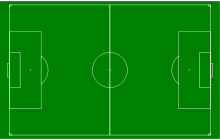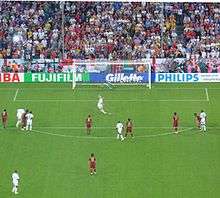Penalty area

The penalty area or 18-yard box (also known less formally as "the penalty box" or simply "the box") is an area of an association football pitch. It is rectangular and extends 16.5m (18 yd) to each side of the goal and 16.5m (18 yd) in front of it. Within the penalty area is the penalty spot (or penalty mark), which is 11 metres (36 ft) or 12 yards from the goal line, directly in-line with the centre of the goal. A penalty arc adjoins the penalty area, and encloses the area within 9.15m (10 yd) from the penalty spot; it does not form part of the penalty area and is only of relevance during the taking of a penalty kick.[1]
Previously, penalty areas extended the width of the field, but were reduced to their current dimensions in 1901.
Functions


Fouls punishable by a direct free kick (i.e. handling the ball and most physical fouls), committed by the defensive team within the penalty area, may be penalised by a penalty kick.[2] A penalty kick is taken from the penalty spot. The penalty spot is located 12 yards (10.97m) away from the goal line.
The penalty area has other functions, including:
- Goalkeepers: The area delimiting the area in which a goalkeeper may legally handle the ball;
- Goal kicks: The ball is not in play until it has left the area, and opposing players must remain outside the area until this time;
- Defensive direct free kicks and indirect free kicks: Again, the ball is not in play until it has left the area, and opposing players must remain outside the area until this time;
- Taking of penalty kicks: players other than the kicker and the goalkeeper must remain outside the area (and also the penalty arc) until the kick has been taken.
In play
In a typical game, for the majority of time the penalty area is only occupied by the goalkeeper. The attacking team generally aims to get the ball and their own players into the defending team's penalty area, and a high percentage of goals in professional football are scored from within the penalty area.[3] Usually during attacking set pieces, including corners, a large number of both attacking and defending players are in the penalty area and, although illegal, grappling between players is frequently observed.[4]
Proposals for change
A mathematics-based new penalty area has been lately (2016) proposed; it is based on considering the actual scoring possibility on the 2 dimensions near the goal [5]. It is shown in the scientific paper that the 150-year-old rectangular area is mathematically disproportionate; this can be causing too much diving or simulation by players around the goal and also too many matches that are decided unfairly. The goal of the new penalty area is to reduce these problems with a novel penalty-area line, or curve, that is based on the proposed scoring potential measure which is in turn based on the angle towards the goal line (between posts) and the distance to the centre of this line. The idea is that as you (or an attacker with the ball) move along the current penalty-area line or lines, the geometric possibility of scoring varies wildly, whereas along the new penalty-area curve the potential of scoring is mathematically the same; this would make the new marking a better limit for the critical and crucial penalty area. Nevertheless, the fully mathematical line or curve may be difficult to implement in the real world of football, which has thousands of tournaments at all –economic and generational– levels of the sport, although field hockey –for example– has for more than 100 years used penalty circles (areas) whose lines are curved.
References
- ↑ http://www.fifa.com/mm/document/affederation/generic/81/42/36/lawsofthegame_2012_e.pdf Laws of the Game at Fifa.com
- ↑ "LAW 12: FOULS AND MISCONDUCT". The FA. Retrieved 28 October 2014.
- ↑ Mitrotasios, Michalis; Armatas, Vasilis (16 January 2014). "Analysis of Goal Scoring Patterns in the 2012 European Football Championship". The Sport Journal. United States Sports Academy. Retrieved 28 October 2014.
Other research has examined the position on the pitch from which goals are scored. In a recent study Wright et al. (50) showed that from 167 goals from English Premier League, 87% of goals were scored inside the penalty area which is similar to the 90% observed by Olsen (36) for the 1986 World Cup whereas Dufour (14) reported 80% for the 1990 World Cup. Yiannakos and Armatas (51) reported that 44.4% of goals scored were inside the penalty area, 35.2% inside the goal area, and 20.4% outside the penalty area, for the 2004 European Championship in Portugal. Finally, Hughes et al. (22) showed that successful teams in the 1986 Football World Cup made more attempts inside the penalty area in comparison to unsuccessful teams.
- ↑ Singh, Amit (27 October 2014). "Should referees take a tougher stance on penalty box holding at set-pieces?". Think Football. Retrieved 28 October 2014.
- ↑ Morales, Cesar (April 2016). "A mathematics-based new penalty area in football: tackling diving". Journal of Sports Sciences.